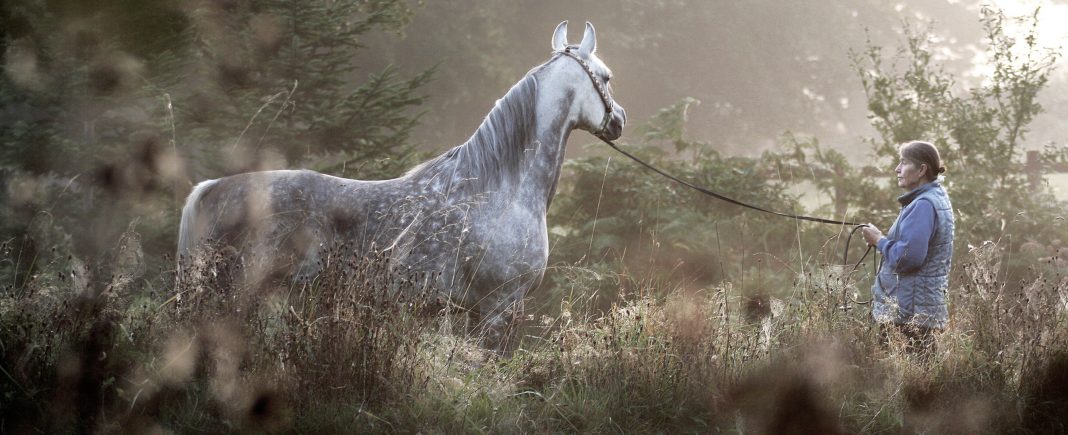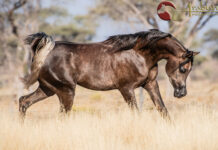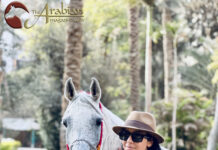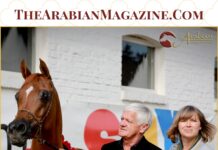Continuing our look back at Lodge Farm Arabians, which was undoubtedly the pinnacle of Arabian breeding in the UK. Founded by Joanna Maxwell along with her husband, the late Major Pat Maxwell, the horses bred at this stud have almost become a bloodline in their own right. ‘Maxwell lines’ is a commonplace term the world over and in May 2011, we dedicated an edition to this breeding programme. In this feature by Joanna and Pat’s daughter, Emma, she shares her recollections of Lodge Farm and the remarkable Arabian horses that came from this small corner of England.
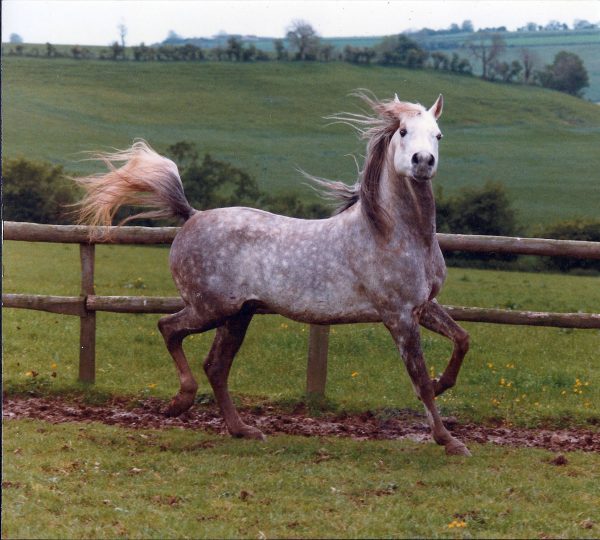
Galerito (Galero x Oba), a straight Spanish Champion and British National Gucci Jumping Champion
Bloodlines that could equally produce excellence at halter and under saddle were always part of the Lodge Farm goal. Many Spanish male horses were imported as well, with varying success, but almost all ended up moonlighting as cross-country horses and general all-round fun rides. For some reason, almost all our Spanish horses seemed to enjoy jumping – as they ably demonstrated by flying from the field back to the yard at weaning time and the family took advantage of this; Pat and Emma took straight Spanish entires Galerito (Galero x Oba) and Vakusko (Garbo x Vakuska) around some fairly hairy great hedges out drag hunting with the Berks and Bucks. Later on, the lovely Spanish and British National Champion Borneo (Thamil x Setubal) joined the farm on a long lease, one of the best straight Spanish stallions of his time. Borneo had some success and is, I believe, the only stallion to sire two ridden champions at the UK International, Al Galero (ex Ayat) and Adawy (ex Ashiqa), both from the Aliha family. His best Spanish daughter, Estonia (ex Estepa), was also successful at Towerlands, being Reserve Champion Filly at halter.
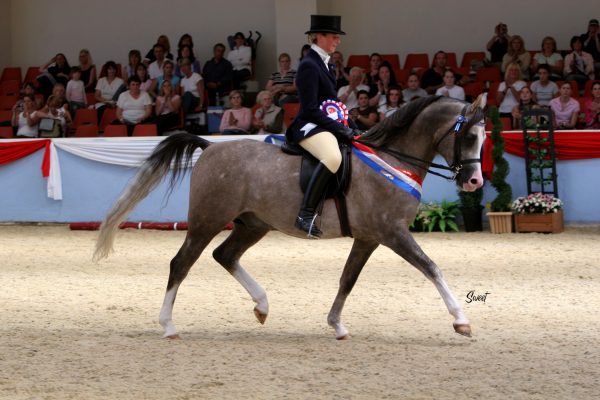
Al Galero
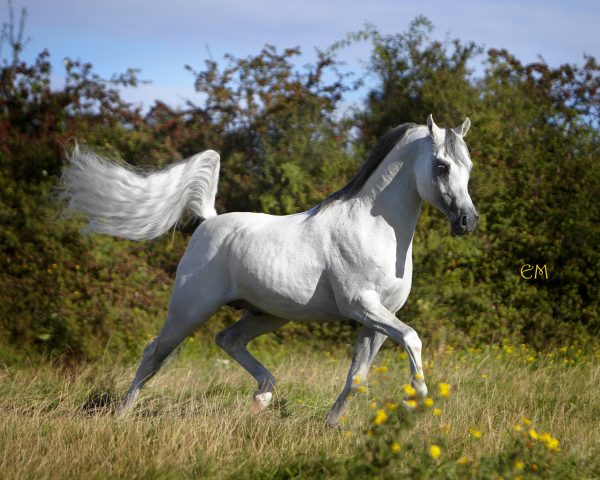
Adawy
In early 1980s, the American show world was fully professional, but there were clearly already some issues with both abuse and buying off judges. At this time, European showing was a fairly motley crew of owner/handlers, all showing in different styles, different outfits and with judges from different countries tending to prefer what their own country produced. Therefore, a group of likeminded breeders, Pat among them, started ECAHO in 1983 to attempt to achieve both some harmonisation between countries and to avoid the pitfalls of the American experience. The overall aim was pithily expressed as trying to stop ‘beating and cheating’. The organisation grew to encompass all of Europe and the Middle East, with Pat standing down as President in 2001 after 18 years at the helm. ECAHO’s attempts to achieve its aims will always be a work in progress but without it, Arabian show breeding in Europe would probably have been a satellite to America as opposed to an alternative. Pat and Joanna dipped their toes into American waters when Aliha was sent over to Tom and Rhita McNair of Glennloch Aarabians to be shown in 1985, where she was a class A Champion, but Scottsdale 1985, where five horses died on the showground for various reasons, left a taste in their mouth that they did not want to repeat and they did not return to the show. That visit was memorably summed up by a Spanish breeder also present, who described it as “the Roman arena, with the horses playing the part of the Christians and the handlers, the lions”.
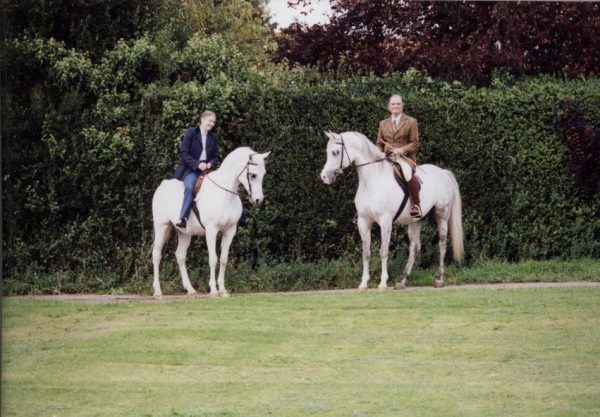
Joanna riding Aliha (Indian Silver x AK Atallah), Pat riding Kordelas (Monogramm x Kabala)
The English/Egyptian/Spanish recipe was the classic early Lodge Farm breeding programme. However the bloodlines were also kept straight as well in an attempt to provide structure to the programme, as endlessly outcrossed horses are not always the most predictable to breed. The Egyptian side of the programme was expanded dramatically in 1988 when the one of the pillars of US Egyptian breeding, Bentwood, went bankrupt and eight mares were added to the programme, followed by another group in 1991 from an Addis auction in Oklahoma. This expansion of Egyptian blood made it clear to us that closed circuit breeding was not all it was cracked up to be as our average number of slipped foals, foal deaths, laminitis and general disaster dramatically increased with all these inbreed pedigrees. However, outcrossing with the straights was a valuable exercise and the cherries on the top of the mixed recipe were the products of Crusader. Crusader was an outstanding colt foal bought on sight in Sweden from Penelope Lewenhaupt while traveling to Stockholm to show horses in 1990. He was nearly 16 hands of extremely typey white straight Egyptian, and while his legs and temperament were not perfect, he provided a leap forward in show type as well as being a magnificent ride and a rather unruly front running sprinter on the track.
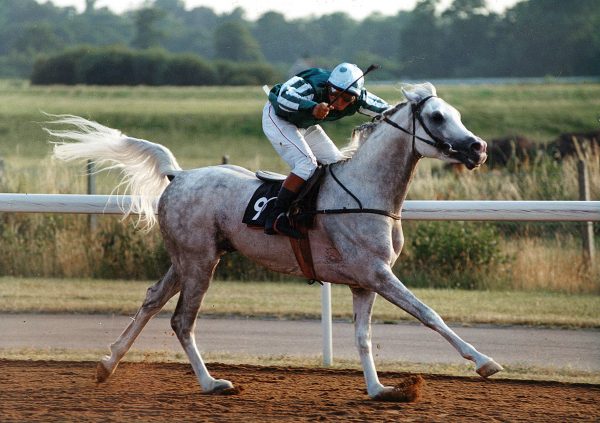
Crusader (Salaa el Dine x AK Kastana) racing
Pat and Joanna visited both Russia and Poland in the early 1980s, but the American market made prices prohibitive for the stock that they liked. In the early days, Polish horses had not appealed to them, in particular as they were lacking in tail carriage and rather straight in the shoulder – a pet hate of the family who had grown up with the valid insistence that a decent riding horse must have a good shoulder. However of all the State Studs, all of whom had a wonderfully high standard of horses in the 1970s, Poland was the only one that did not rest on its laurels, but continued to improve its stock by judicious outcrossing. By the end of the 1980s, when the EAO, the Yeguada Militar in Spain and, to a lesser extent, Tersk in Russia had rather collapsed in on themselves, Poland was steaming ahead and it was clearly producing some of the best horses in the world, as it still is. At the same time the US market, which was built on the shifting sands of favourable tax laws and a lot of very underhand ‘auction’ prices, had collapsed in 1986 when the laws were changed and the prices of the sort of Polish mares that Pat and Joanna fancied finally came within reach. Czata (Banat x Cyrkulacja) was purchased in 1990 for $33,000 and became twice Nations Cup Champion Mare, although she proved harder to breed than we had optimistically assumed and did not cross well with either Maleik el Kheil or Crusader, both of whom were great sires on our usual bloodlines. Experimental breedings were always part and parcel of the farm, and we found by experience that some lines nicked perfectly and others did not. At one point, we tried to reintroduce some old desert blood as well with an old Jordanian stallion Thamin (Mehrez x Zobeida), but he only sired two colts, neither good enough for the programme at the time. We later stuck to the practice of breeding Polish horses mainly within Polish and Russian lines and they proved more predictable this way.
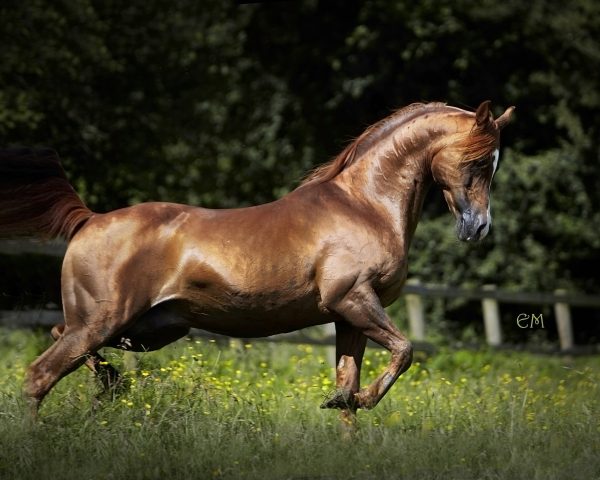
Premier
For Emma, the effects of winning a World Championship with Rumak, a notoriously on the edge stallion to show, combined with nearly a decade escorting the not remotely helpful Crusader around the ring, meant that her training yard had been flooded with other difficult characters. Thus her 1999 vision of Premier (Monogramm x Premiera) dancing through the arch at the Polish auction was irresistible and she bought him herself, if only to finally have a stallion to show that was straightforward, a wish that Premier certainly granted. The delightful temperament of Premier and the other Russian and Polish State Stud stallions taught us that the State systems of raising colts in a herd and racing them in their most obstreperous years were far better at producing a really good-natured final product and we tried to emulate this by keeping our colts wintered together in barns and turned out in groups for some ‘horseplay’ rather in stables as spoilt individuals. Temperament wise, it was also clear that the halter training methods in the United States were not producing an end product that was much fun to deal with. Most of the American horses that came to the farm who had had a show career previous to import were potentially dangerous if you raised a whip near them, or they kicked when you approached the tail end in anticipation of being gingered. This made the claim that they had been professionally trained somewhat laughable, ‘trained to do what?’ was the obvious question.
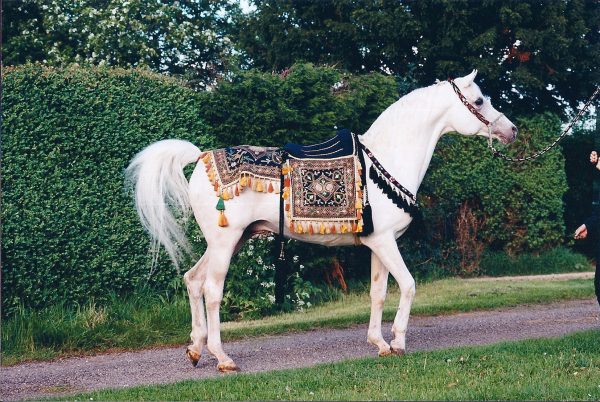
Mascat (Aswan x Malutka) with the Sire Produce Saddle
Russian horses had long been on the radar as the type of horse we would like to have in the breeding programme, mainly for that spectacular movement that was unique to them, but in 1984 when Pat and Joanna visited Tersk, the reserve price on a nice breeding stallion such as the Aswan son Mascat was a million dollars. Needless to, say few horses sold at these prices and certainly not to Lodge Farm. However, Lodge Farm made history in 1985, by selling a horse to Tersk instead, sadly only for £20,000, the first Western purchase made by the stud since 1936. British National Champion Esplendor (Ghadames x Esperada) was delivered in person to a Russian border guarded every 100 metres by a guard with Kalashnikov after a 10-day journey filled with all the uncertainty that involved crossing the Iron Curtain in those days. His Tersk-bred daughter Emotsia was then bought in 1990 and two high-grade Russian stallions were leased in the 1990s – Pakistan (Kumir x Panagia), a half-brother to Balaton, and Mascat (Aswan x Malutka), who arrived aged 19 in 1994 from the Khrenovoe Stud. Mascat eventually stayed and was exchanged for Polish racehorse Egis (Penitent x Estrada). Mascat was greatly prized as a completely classic Arabian in type with performance credentials and, as you got to know him, an enormous character. He produced the stud’s only major race winner with Pharlap (ex Valentina Bint Procyon) who won the Białka Prize in Poland, the three-year-old championship race, although Pharlap was chased home by another Lodge Farm-bred horse, Maahir, again from the Crusader/Maleik el Kheil/Spanish recipe. Mascat also completed one of Lodge Farms versatility goals by producing Angelikah (ex Akbura), who both won on the track and is a National Champion Mare at halter, a feat that these days is extremely hard to achieve for a private breeder. Alas, versatility is no longer a goal of many high-profile Arabian breeders as specialisation has raised the bar in each category.
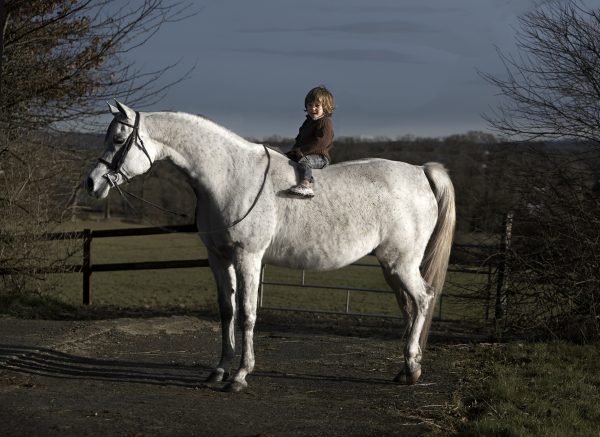
Angleikah with Emma’s son, Isaac
Lodge Farm had a long relationship with racing; Pat was an amateur National Hunt jockey in his youth and completed the formidable Aintree track in the Topham Trophy on a stallion he bred himself. Pat and Joanna bred thoroughbreds for the flat in tandem with the Arabians until 1973 and when Arabian racing started in the late 1970s, Pat and, later, daughters Lucy and Emma both dabbled in racing horses trained at home. Pat was also second in the AHS Marathon in 1978. Atlantica was undoubtedly the only non-Polish World Champion to be shovelled off the racetrack after her win, where she managed a second trained from home. The ethos of the Polish and Russian studs, who raced their youngsters as a soundness test before breeding was greatly admired, but was only possible to emulate in the 1990s after the fall of the Iron Curtain when Poland allowed foreign breeders to send horses to the Warsaw track. The exchange rate made it comparatively cheap to send three year olds out for a season and many Lodge Farm youngsters went to Poland to try their luck. We found that the system of training at the track they raced on and the starting out gates, instead of from a tape start, meant that you could successfully re-school them into far more sensible rides than those that raced in the UK. The latter sweated up on every lorry ride in anticipation and tried to run away on every stretch of grass you stepped onto, especially if another horse was around. Both Mascat and the Crusader offspring had some success in Poland, but since the 1980s it had been clear that to be at top level in racing, you had to include French blood. French horses did not have many Arabian features and the fact that in their early days they ran pure-breds and Anglos in the same races did not endear us to their pedigree credentials as in UK racing, it was abundantly clear that Anglos and pure-breds could not compete in the same races. However a soundness and rideability test of some sort for breeding stock seemed necessary to us to ensure that we were not breeding type features to the detriment of functionality as has happened in dog breeding.
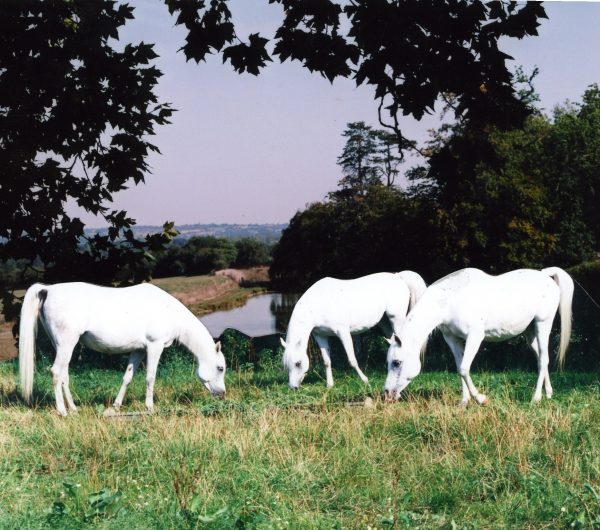
Ashiqa, Atlantica, and Aliha
Making a living from breeding horses is not the sanest way to lead a life, but for many years it gave the Maxwell family unforgettable opportunities, travelling far and wide, meeting an extraordinary range of people, getting to know and then losing many Arabian horses, each of them very different individuals. However in 1998, Pat and Joanna decided to retire from the front line as ‘big breeders’; running a stud of around 80 horses was immensely hard work, very expensive and financially unstable with no other income to back it up in the lean years. Most of the horses were sold, all around the world with just a handful staying with Pat and Joanna on their move to France in 2002. However, Pat did manage to purchase Polish National Champion Mare Grenlandia (Eukaliptus x Getynga) at the Polish auction in 2000, unseen by the rest of the family! After the move to France, no more than three foals were bred each year, mainly in a modern style, by shipped and frozen semen by other people’s stallions. 2010 saw the last foals bred by Pat and Joanna as a couple, two fillies by Ecaho (Pepton x Etruria), the Polish stallion named after the organisation that Pat spent so much of his time trying to perfect, and out of two Mascat daughters, one of whom, Mandolinn, is a great-great-granddaughter of Kazra, with whom it all began.
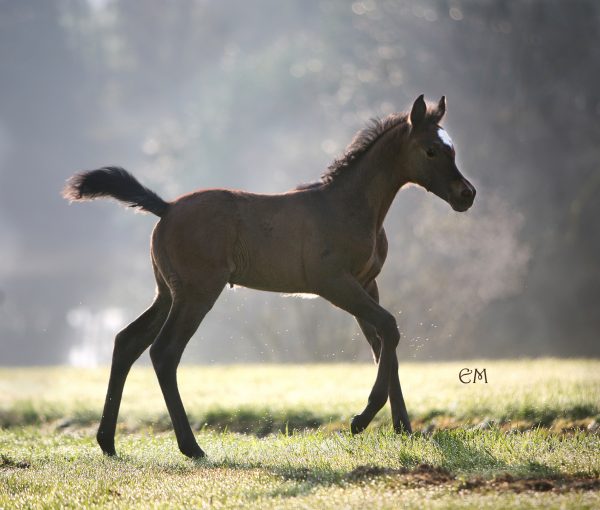
Mandalay (Ecaho x Mandolinn)
To read part one, click here.


